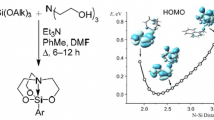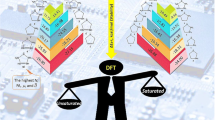Abstract
1-Methyl-4-silatranone could exhibit the structural aspects of a typical silatrane including a short N–Si bond distance reflecting a dative bond. But given the significant amide resonance in a [3.3.3] bridgehead bicyclic lactam, the lone pair could be shared with the carbonyl group leading to a very long N–Si bond, essentially a “non-silatrane.” Ab initio calculations (MP2/6-311 + G*) predict that ground state conformations of this molecule are best regarded as lactams rather than silatranes, the most stable having a calculated N–Si bond length of 2.902 Å and an N–CO bond length of 1.387 Å. The calculated transition state for inversion of the amide ring retains very little amide resonance (N–CO, 1.440 Å). Some of this loss is compensated through tightening of the N–Si bond (2.422 Å), leading to a net energy of activation of ca 8 kcal/mol. Attempts to synthesize 1-methyl-4-silatranone using conventional pathways successful for 1-methylsilatrane [condensations employing N,N-bis(2-hydroxyethyl)glycolamide in place of tris(2-hydroxyethyl)amine] were unsuccessful. This is due to the net loss in resonance energy of the amide reactant relative to that in the [3.3.3] system, the essential absence of the N–Si dative bond, and the rigidity introduced by the planar amide linkage in the starting material. A more likely pathway to successful synthesis should be formation of the amide linkage in the final step.

Similar content being viewed by others
References
Frye CL, Vogel GE, Hall JA (1961) J Am Chem Soc 83:996–997
Voronkov MG (1966) Pure Appl. Chem 13:35–59
Puri JK, Singh R, Chahal VK (2011) Chem Soc Rev 40:1791–1840
Hargittai I, Hargittai M (1987) In: Liebman JF, Greenberg A (eds) In molecular structure and energetics, vol. 2. Physical measurement. VCH Publishers, New York, pp. 1–35
Párkányi L, Hencsei P, Bihátsi L, Müller T (1984) J Organomet Chem 269:1–9
Párkányi F, Bihátsi L, Hensei P (1978) Cryst Struct Commun 7:435–440
Lyssenko KA, Korlyukov AA, Antipin MY, Knyazev SP, Kirin VN, Alexeev NV, Chernyshev EA (2000) Mendeleev Commun 10:88–90
Korlyukov AA, Antipin MY, Bolgova YI, Trofimov OM, Voronkov MG (2009) Russ Chem Bull 58:25–30
Stachel SJ, Ziller JW, Van Vranken DL (1999) Tetrahedron Lett 40:5811–5812
Belyakov S, Ignatovich L, Lukevics EJ (1999) J Organometal Chem 577:205–210
Gordon MS, Carroll MT, Jensen JH, Davis LP, Burggraf LW, Guidry RM (1991) Organometallics 10:2657–2660
Belogolova EF, Sidorkin VF (2013) J Phys Chem A 117:5365–5376
Anglada JM, Bo C, Bofill JM, Crehuet R, Poblet JM (1999) Organometallics 18:5584–5593
Attar-Bashi MT, Richard CEF, Roper WR, Wright LJ, Woodgate SD (1998) Organometallics 17:504–506
Forgacs G, Kolonits M, Hargittai I (1990) Struct Chem 1:245–250
Shen Q, Hilderbrandt RL (1980) J Molec Struct 64:257–262
Shishkov IF, Khristenko LV, Rudakov FM, Golubinskii AB, Vilkov LV, Karlov SS, Zaitseva GS, Samdal S (2004) Struct Chem 15:11–16
Imbenotte M, Palavit G, Legrand P (1984) J Raman Spectrosc 15:293–295
Voronkov MG, Zel’bst EA, Vasil’ev AD, Molokeev MS, Kuznetsova GA (2014) Dokl Chem 458:172–175
IUPAC Name (X = CH3): 1-methyl-2,8,9-trioxa-5-aza-1-silabicyclo[3.3.3]undecan-4-one.
Greenberg A, Moore DT, DuBois TD (1996) J Am Chem Soc 118:8658–8668 (COSNAR: “Carbonyl Substitution Nitrogen Atom Replacement”)
Szostak M, Aube J (2013) Chem Rev 113:5701–5765
Morgan, JP (2014) Two studies in bio-organic chemistry and toxicology. Doctoral Dissertation, University of New Hampshire, Durham, New Hampshire.
Sidorkin VF, Belogolova EF, Doronina EP (2015) Phys Chem Chem Phys 17:26225–26237
Gaussian 09, Revision D.01, Frisch, M. J., Trucks, G. W., Schlegel, H. B., Scuseria, G. E., Robb, M. A., Cheeseman, J. R., Scalmani, G., Barone, V., Mennucci, B., Petersson, G. A., Nakatsuji, H., Caricato, M., Li, X., Hratchian, H. P., Izmaylov, A. F., Bloino, J., Zheng, G., Sonnenberg, J. L., Hada, M., Ehara, M., Toyota, K., Fukuda, R., Hasegawa, J., Ishida, M., Nakajima, T., Honda, Y., Kitao, O., Nakai, H., Vreven, T., Montgomery, J. A. Jr., Peralta, J. E., Ogliaro, F., Bearpark, M., Heyd, J. J., Brothers, E., Kudin, K. N., Staroverov, V. N., Kobayashi, R., Normand, J., Raghavachari, K., Rendell, A., Burant, J. C., Iyengar, S. S., Tomasi, J., Cossi, M., Rega, N., Millam, J. M., Klene, M., Knox, J. E., Cross, J. B., Bakken, V., Adamo, C., Jaramillo, J., Gomperts, R., Stratmann, R. E., Yazyev, O., Austin, A. J., Cammi, R., Pomelli, C., Ochterski, J. W., Martin, R. L., Morokuma, K., Zakrzewski, V. G., Voth, G. A., Salvador, P., Dannenberg, J. J., Dapprich, S., Daniels, A. D., Farkas, Ö., Foresman, J. B., Ortiz, J. V., Cioslowski, J., Fox, D. J. Gaussian, Inc., Wallingford CT, 2009.
Spartan 14, 1.1.0, Wavefunction Inc., Irvine, CA.
Daryaee F, Kobarfard F, Khalaj A, Farina P (2009) Eur J Med Chem 44:289–295
Dunlap-Smith A (2016) Computational chemistry of silatranes. Testing the limits of modern Density Functional Theory. Dissertation for the Bachelor of Science in Chemistry, University of New Hampshire, Durham, NH.
Acknowledgments
We gratefully acknowledge the Department of Chemistry, University of New Hampshire, for support of Holly M. Weaver-Guevara, Ryan Fitzgerald, and Azaline Dunlap-Smith and also acknowledge the helpful experimental contributions by Mathew Rauch and Brent Lawson as well as suggestions by Dr. Alka Prasher and Dr. Istvan Hargittai.
Author information
Authors and Affiliations
Corresponding author
Additional information
This article is dedicated to Nobel laureate Professor George A. Olah who made evanescent carbocations accessible and visible to all interested researchers.
Electronic supplementary material
ESM 1
(DOCX 215 kb)
Rights and permissions
About this article
Cite this article
Morgan, J.P., Weaver-Guevara, H.M., Fitzgerald, R.W. et al. Ab initio computational study of 1-methyl-4-silatranone and attempts at its conventional synthesis. Struct Chem 28, 327–331 (2017). https://doi.org/10.1007/s11224-016-0871-1
Received:
Accepted:
Published:
Issue Date:
DOI: https://doi.org/10.1007/s11224-016-0871-1




